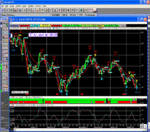Ta for the chart Mad, and thanks for expanding further Skimmy.
Money123, would I reccomend a charting package? No, I wouldn't.
It's a rather personal thing really, a bit like some people drive Ford motor cars because they like them and other people hate them and will only drive Nissans, yet they both do the same thing.
Madasafish I know uses Linnsoft and Skim (and myself) use Sierra. Though I should think most people have tried various packages. I use Sierra simply because they work off a price feed from interactive brokers who I trade with, and are real time. They aren't the best charts in the world, yet they are reasonably priced and they improve them with each build that comes out. The best charts I have used so far have been from Market Eye, but they are expensive. It depends on what you want to do. If you want to sit in front of a screen(s) all day and trade live where a delay in the feed of 2 secs can cost you £50, then you need real time. If you are going to swing or trade over a longer time period then end of day may be more suitable (and cheaper.)
I can tell you what packages to avoid though. All those that are predictive and give trading signals. You will need deep pockets to suffer any drawdowns. Course you may get one that works, but then we would all have it. And we can't all be right all of the time. Otherwise we wouldn't have a market.
Fibs? Sorry, it's short for Fibonnaci, a maths geezer who worked with numbers. I won't go into it here, (too long and complex. Try a search on google.) But fib lines have an uncanny knack of calling the sup and res lines right. Mind you, if you put a grid over a Chart, you can see where congestion is building up for yourself.
Fib lines are projected into the future part of a chart, so you can see where the price 'may' turn.
Back to charts. Lycos do 'live' charts of the Nasdaq and the usa indices, but bear in mind that if you trade these you will be going up against people like 'Naz' (for stocks) who use level 2 screens to give added insight into what's happening and in effect you will be trading with one eye shut..
There are quite a few decent sites around for eod data.
www.inverline.com is one. You can practise trading of sup and res using these.
Sometimes it is better to wait until a price has broken (or not) the sup and res and then trade it.
Good luck.
Options.

